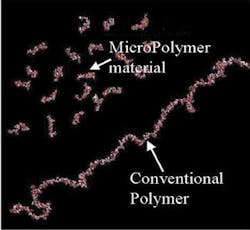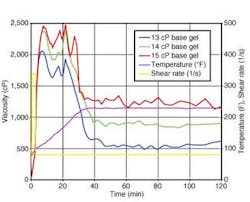pH-controlled fluid can build viscosity quickly without breakers
The use of a visco-elastic fluid system with the accompanying MicroPolymertrademark material resulted in a 25-30 times smaller polymer requirement, compared with conventional treatment. To develop visc-osity, the fluid links and de-links based on pH, unlike conventional polymer-based fluids, do not require breakers.
The fluid system's rapid response enables real-time viscosity control, allowing operators to adjust a fracturing fluid's formulation almost instantaneously. The adjustment is based on observed treatment responses such as surface pressure.
For years, water-based polymers, guar, and derivatized guar have been mainstays for conventional fracturing fluids, providing operators with a low-cost, highly controllable rheology frac fluid. But even with the highest-quality guar-based, low-polymer fluid system and highly efficient breaker, a high percentage of the fracture conductivity can be lost to frac fluid damage, leading to poorer-than-expected well productivity following fracture stimulation. Considerable efforts have been applied to improve the performance of these frac fluids, which have:
- Incrementally improved conductivity, including the application of special purification chemical processes
- Allowed formulation of fluids with less polymer
- Improved polymer breakers and fluid recovery during well flowback after treatment.
Fluid limitations
The use of polymer-free visco-elastic frac (fracture) fluid technology has demonstrated that these fluids are generally considered non-damaging. However, their application at high temperatures is limited due to the fluid's high fluid loss and consequent inability to generate extended fractures and competently transport proppant at a reasonable cost.
In field trials, the Halliburton MicroPolymer fluid system created productive fractures with low conductivity damage, while still providing fluid loss control and proppant transport properties. The fluid system combines the properties of both polymer-based and surfactant-based fluids and is virtually clear and clean. The fluid has almost-perfect proppant transport.
The fluid system exhibits little degradation with time and temperature and also shows low salinity sensitivity and real-time controllable rheology. The fluid system can provide polymer-like fluid rheology and fluid loss control without high molecular weight polymer chains. This is accomplished by creating a high molecular weight transitory-linked polymer, once short molecular units are combined with a reversible-linking component.
Since this transient-linked polymer (Transient Gel™ technology) is pH reversible, it requires no polymer chain breakers. After pumping has stopped, the freshly fractured formation alters the injected fracturing fluid to the naturally occurring pH of the formation thereby delinking the fluid.
The solution pH and linker quantity can determine the strength of the transitory linkages. It is also possible to control the linking time by adjusting the fluid's pH, which can provide increased control for long pumping time treatments.
Preparation
Because the short-chain molecules are highly concentrated, no hydration time is required, and only simple dilution with fresh water is needed to prepare the fracturing fluid. Advanced blending equipment can deliver the short-chain molecule concentrate directly to the blender so that it can be diluted at any required ratio.
Modifying the dilution ratio changes the base fluid viscosity, making real-time rheology control feasible. This control can be a major advantage during the early stages of a fracturing treatment, because viscosity can be increased to overcome wellbore tortuosity and initiate the fracture. During the treatment, rheology can also be adjusted to control fracture height growth and the formulation can be ramped based on formation cool-down response.
The ability to control fluid properties in real time is a significant advancement in fracturing as it allows the fluid rheology to be changed based on real-time treating responses. The adjusted fluid will reach the formation within the pipe travel time rather than the 20-60 minutes it can take for conventional fluids to adjust on surface and reach the formation. This results in getting the right amount of the right fluid type, at the time it is needed, for the best fracturing response. There are other advantages:
- Because only fresh water is stored and used on the wellsite, the chances of spillage and the brine disposal costs for unused water are reduced.
- Since most of the additives are premixed with the highly concentrated short-chain molecules, the total number of liquid additives required on-site is dramatically decreased compared to conventional fracturing fluids.
- Pre-mixing also reduces the risk of site contamination.
- Monitoring and metering fewer liquid additives can aid in fluid quality control.



